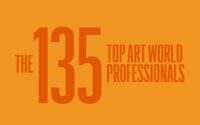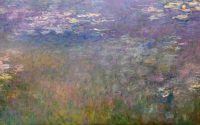Africa’s Leading Fair 1-54 Gains a Foothold in Asia with Hong Kong Exhibition at Christie’s
In October, Touria El Glaoui, the founder of the 1-54 Contemporary African Art Fair, announced that the fair would hold its first outing in Asia. After a decade in business, 1-54, which stages editions in New York, London, and Marrakech, has been influential in centering the work of contemporary artists from Africa and its diaspora—and creating a market for their work. And now, it has ventured into another part of the world.
Consisting of consigned works from galleries in its network, the exhibition, titled “Coalescent Lights,” opened on Monday night at Christie’s headquarters in Hong Kong, a day before the VIP opening of Art Basel Hong Kong, the main draw in the city this week. On view until March 30 are 20 works on display by artists who are well established across the African continent like Omar Ba, Virginia Chihota, Sanaa Gateja, Abdoulaye Konaté, Ibrahim Mahama, Zanele Muholi, Moffat Takadiwa, amd Ouattara Watts.
The show’s organizer is Kami Gahiga, a Rwandan-born, London-based adviser who El Glaoui brought on to oversee 1-54’s relations with clients and art foundations in March 2023. Now a full year into the role, Gahiga spoke with ARTnews about the fair’s aims to test the Hong Kong’s interest in African art.
This interview has been edited and condensed for clarity.
ARTnews: It’s been just over 10 years since the fair was founded. Tell me about what led up to this decision to come to Asia finally.
Kami Gahiga: 1-54 started in 2013 in London where its headquarters are and then expanded to Marrakech and New York. When Touria [El Glaoui] started 1-54, there were really not many Black African artists at international art fairs. This is the first showcase in Asia for us; the exhibition is a different model that the fair has started to develop. We had our first [1-54 Presents, a series of curated shows,] in New York in May 2023. Then a second in London at Christie’s, in October.
We were thinking: how can we still engage our audience, the people who come to the fair, but also the artists and galleries? How do we present works by artists of African descent in a way that is dignified, that really puts them into context? The model, it was very conscious, because we understand that perhaps there has been less exposure here [in Asia] in terms of works by contemporary artists of African descent. We wanted to give a glimpse into the developments within the contemporary art scene.
With the format, there’s a pairing of historical artists with living ones, many who are active on the biennial circuit. Can you tell me about that choice?
There are artists like Ibrahim El-Salahi, who is considered the father of African modernism; photographer Seydou Keita; or Algerian artist Baya, who has on view a work from 1979. They’re shown alongside living artists like Ibrahim Mahama, who has a large-scale commission that’s coming up at the Barbican [in London] in April.
You partnered with galleries and artists, much like a traditional fair, who provided the works on consignment. Many of the artists have shown in 1-54 and they’re already established.
We work directly with galleries, so we’re in dialogue with them and the artists in the show. The conditions of sales, that’s not something that we’re negotiating on behalf of galleries. We’re not really involved in the sales process.
How would you characterize the various art scenes in Africa that 1-54 is trying to highlight?
I’m from Rwanda originally, so there is a lot of back and forth between East Africa and Europe and America. I spent quite a lot of time on the continent as well and there are more and more developments in terms of institutions being built 1711496274. Some countries are supporting the scene and you see it across the continent. Many artists who have found success internationally have opened cultural centers in their own countries and respective cities in order to sort of support the next generation of artists.
Prince Gyasi, a Ghanian photographer who is on the rise, is also in the show. He’s young but has set up his own arts organization in Accra. In January, he did a collaboration with Balmain and shot a Prada campaign for Vanity Fair in 2021.
He’s well known for his hyper-saturated chromatic photographs. They’re really striking. He’s quite an interesting photographer because of his collaborations with luxury designers.
In addition to the 1-54 show, this edition of Art Basel Hong Kong also saw the launch of the first-ever International Cultural Summit that brought a lot of museum leaders to the city. Did that factor into the fair’s interest in coming to Hong Kong this year?
That was a consideration. The Hong Kong art market is well-developed, and collectors here have seemed really open. They’ve been so much interest. We’re still in conversations, but we’re happy to say that there’s been a few institutional closings [on artworks].
Is returning to Hong Kong a part of the plan?
We had a group of collectors that came from Japan and number from Seoul visit the exhibition. So it’s not just Hong Kong, but it’s also that Hong Kong is a major arts center in Asia. Eventually, we’ll have a full-fledged fair in Hong Kong.



